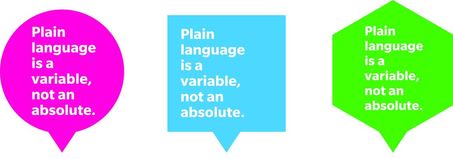What is plain language?
|
Plain language, defined
Plain language is communication that brings the needs of the intended audience into harmony with those of the writer. It lets the writer get his message across, and it makes it easier for people to understand the information that is important to their lives. According to the highly-regarded Centre for Plain Language, written material should be assessed by whether the reader can:
Language that is clear, or plain, for one group of people may be nonsense to another. We must consider the readers' cultural context, vocabulary, and expectations, and pay attention to document design and presentation as well as writing. You know it when you see it.
Myths about plain language
Let me try to dispel some common myths. Myth #1: There is only one plain language. Plain is plain. Plain language is language that is easily understood by the intended reader. It changes with different audiences. If you write for insurance agents you can use industry jargon. If you write for first-time auto-insurance buyers, you need to offer more definitions of insurance jargon. If your reader’s first language is not English, you need to avoid culturally-specific concepts. Plain language is targeted to particular readers, so there is always a range of plain language. Myth#2: Plain language documents are short. To make information understandable, you have to provide disclosure, context, and definition. These may make your document longer that would otherwise be necessary.
Myth#3: Plain language is only about words. Plain language has come to mean a modern communications process involving several stages. The process requires that you research the subject, research the readers' interests and abilities, brainstorm the purpose of the communication, plan the best format, draft by committee or individual, edit by a second person, lay-out and design to serve the purpose and message, try-out the document with readers who represent the target audience, revise the text and design after receiving feedback. Plain language is a multifaceted approach to writing style and a communications process. Myth #4: Plain language is OK for correspondence but we don’t have time for any new schemes. Plain language is OK for correspondence and for every other kind of document you circulate internally or externally. It has been applied to contracts, annual reports, prospectuses, marketing brochures, forms and so on. Plain language is easily integrated into customer-service or other communications or quality-improvement programs. Myth #5: There are no plain language experts. There is a wealth of research available to support best practice standards for plain language process and editing guidelines. For plain language writers, there are many courses available. Training is also available in how to conduct evaluations and audience research. For example, in Sweden over 3 decades plain language consultants have graduated from a two-year college certificate program in plain Swedish. Centers of expertise operate in other countries. Plain language experts are found in many countries and in many industries. Myth #6: Plain legal language may not be possible. The law has inherent complexities. In “Style: Toward Clarity and Grace”, Joseph Williams wrote: “Whether we are readers or writers, teachers or editors, all of us in professional communities must understand three things about complex writing:
Plain language in contracts could reduce the pressures on the courts. In 1992 The Legal Writing Institute, then comprising more than 900 legal research and writing teachers, endorsed plain legal language, saying, “The language used by lawyers should agree with the common speech, unless there are reasons for a difference... Legalese is unnecessary and no more precise than plain language.” Clarity is an international organization of over 800 lawyers, academics and others interested in simplifying legal language. The US Securities and Exchange Commission has led the charge to demonstrate how companies can communicate in plain language. It released a guide, “The S.E.C. Plain English Handbook”. Plain legal language is being written every day. Plain legal language may take more time, energy and resources but it is possible and always preferable. Myth #7: Plain language leads to litigation. Citibank came out with a plain language consumer note in 1973. In 1978 New York passed a law requiring residential leases be in plain language. Since then over 30 states have legislated requirements for plain language in consumer finance, real estate and insurance documents. There has been no avalanche of lawsuits arising from the plain language. Not even a trickle. Poor legal writing is poor legal writing – even when it is plain. Don’t blame the plain language, blame the drafter. In some contracts, the drafter has assumed that industry practice will still be used to interpret the language of the contract because this was done in the past when language was unclear or ambiguous. If the court finds that the plain language of the contract is clear and self-explanatory, it will not look outside the contract for meaning. The courts will not correct sloppy drafting by looking to the surrounding circumstances, the industry practice, or oral interpretations that were offered. In fact, courts have begun to say, The contract was in plain language. There was an obligation on the consumer to read it. They will be bound by the plain language of the contract. If you are going to write a contract in plain language, make sure you know the law and know what you are doing. Myth #8: Anybody can write a plain language document. Anybody can excise a snakebite in an emergency, but, given the choice, would you have it done by your mechanic or your doctor? Many organizations have their own staff write material according to prior precedents, and assume it will be satisfactory when it hits the courts. Some try to do their own plain language revisions of legal documents. Anybody can rewrite a legal document but then, there is no guarantee that it will be legally effective. If you don't want to pay a lawyer to revise your documents, don't. But do send your plain language documents to your lawyer for a legal review. There are lawyers who are also trained as plain language writers so it is possible to do one-stop shopping for good quality, effective, plain language legal documents. Break out of the mold and the myths. Many of these myths are rooted in bad experiences or failed attempts at plain language. If at first you don’t succeed with plain language, take some training, work with plain language consultants, ask your clients for feedback on your document style. You will find that your plain language gets easier and increases in effectiveness, with time and practice. Plain language consistently creates more success stories than failures. Statistics show dollar savings and customer satisfaction arising from plain language. Forget the reasons not to, try plain language -- you’ll like it. This article was written by Cheryl Stephens for original publication in LegalFocus (Vol.1 No.15), publication of the insurance industry, http://longwoods.com This version is updated. |
Plain Language:
|

